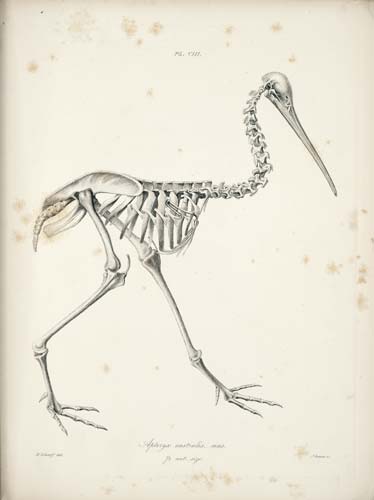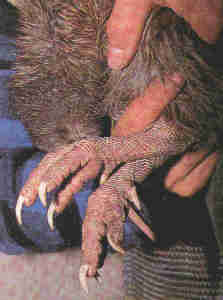Anti-Creationists......time to speak your clout
Options
Comments
-
However.....
Not all "flightless" birds are in the ratite family.......
Struthionidae - ostrich
Rheidae - rhea
Casuariidae - cassowary
Dromaiidae - emu
†Aepyornithidae - elephant bird
†Dinornithidae - moa
Apterygidae - kiwi
Several other species of flightless birds....
What makes you so certain that the kiwi "wings" are for flight????
-
However.....
Not all "flightless" birds are in the ratite family.......
^^^ More incorrect information.
Ratite is defined as
Relating to or being any of a group of flightless birds having a flat breastbone without the keellike prominence characteristic of most flying birds.
http://www.thefreedictionary.com/ratite
and
a bird with a flat breastbone; especially : any of various mostly flightless birds (as an ostrich, rhea, emu, moa, or kiwi) with small or rudimentary wings and no keel on the sternum that are probably of polyphyletic origin and are assigned to a number of different orders
http://www.merriam-webster.com/dictionary/ratiteStruthionidae - ostrich
Rheidae - rhea
Casuariidae - cassowary
Dromaiidae - emu
†Aepyornithidae - elephant bird
†Dinornithidae - moa
Apterygidae - kiwi
Several other species of flightless birds....
These are families; the order is Struthioniformes, which refers to all ratites, or flightless birds.
This is a small order with some very remarkable birds in it. It includes 5 families all of which were until recently given ordinal status in their own right, however, modern DNA information and cladistic analyses have brought them all together in one order. These five families are called Ratites and are all flightless birds without a keeled breastbone. They are all primarily herbivorous to omnivorous.
http://www.earthlife.net/birds/struthioniformes.htmlWhat makes you so certain that the kiwi "wings" are for flight????
wing
One of a pair of movable organs for flying, as the feather-covered modified forelimb of a bird or the skin-covered modified digits of the forelimb of a bat.
http://www.thefreedictionary.com/wing
1a : one of the movable feathered or membranous paired appendages by means of which a bird, bat, or insect is able to fly; also : such an appendage even though rudimentary if possessed by an animal belonging to a group characterized by the power of flight b : any of various anatomical structures (as of a flying fish or flying lemur) providing means of limited flight
http://www.merriam-webster.com/dictionary/wing
-

However.....
Not all "flightless" birds are in the ratite family.......
Struthionidae - ostrich
Rheidae - rhea
Casuariidae - cassowary
Dromaiidae - emu
†Aepyornithidae - elephant bird
†Dinornithidae - moa
Apterygidae - kiwi
Several other species of flightless birds....
What makes you so certain that the kiwi "wings" are for flight????These are families; the order is Struthioniformes, which refers to all ratites, or flightless birds.
For example there are.......
Anseriformes (Waterfowl)
Campbell Teal
Moa-nalos (extinct)
Bermuda Island Flightless Duck †
Fuegian Steamer Duck
Falkland Steamer Duck
Chubut Steamer Duck
Auckland Teal
Campbell Teal
Dromornis †
Genyornis †
Chendytes lawi †
Talpanas †
Cnemiornis †
Galliformes (Wildfowl)
New Caledonian Giant Megapode †
Podicipediformes (Grebes)
Junin Grebe
Titicaca Grebe
Atitlán Grebe † (reportedly flightless)[5]
Pelecaniformes (Pelicans, Cormorants and allies)
Flightless Cormorant
Flightless Cormorant
Sphenisciformes (Penguins)
Penguins
Coraciiformes (Kingfishers, Hornbills and allies)
Giant Hoopoe †
Ciconiiformes (Herons, Ibis)
Apteribis †
Jamaican Ibis †
Réunion Sacred Ibis †
Leptoptilos robustus †
Gruiformes (Cranes, Rails)
Weka
Great Auk
Cuban Flightless Crane †
Red Rail †
Rodrigues Rail †
Woodford's Rail (probably flightless)
Bar-winged Rail † (probably flightless)
Weka
New Caledonian Rail
Lord Howe Woodhen
Calayan Rail
New Britain Rail
Okinawa Rail
Guam Rail
Roviana Rail (flightless, or nearly so)[6]
Tahiti Rail †
Dieffenbach's Rail †
Chatham Rail †
Wake Island Rail †
Snoring Rail
Inaccessible Island Rail
Laysan Rail †
Hawaiian Rail †
Kosrae Crake †
Ascension Crake †
Red-eyed Crake
Invisible Rail
New Guinea Flightless Rail
Lord Howe Swamphen † (probably flightless)
North Island Takahe †
Takahe
Samoan Wood Rail
Makira Wood Rail
Tristan Moorhen †
Gough Island Moorhen
Tasmanian Nativehen
Giant Coot (adults only; immatures can fly)
Adzebills †
Charadriiformes (Gulls, Terns, Auks)
Great Auk †
Diving Puffin †
Falconiformes (Birds of prey)
Dodo
Terrestrial Caracara †
Psittaciformes (Parrots)
Kakapo
Broad-billed Parrot †
Columbiformes (Pigeons, Doves)
Dodo †
Rodrigues Solitaire †
Viti Levu Giant Pigeon †
Caprimulgiformes (Nightjars)
New Zealand Owlet-nightjar †
Strigformes (Owls)
Cuban Giant Owl †
Cretan Owl † (probably flightless)
Andros Island Barn Owl †
Passeriformes (Perching Birds)
Stephens Island Wren †
Long-legged Bunting †
The majority of this list possessing a keel...... the Encyclopedia of New Zealand wrote: »Most birds have a raised central keel on their breastbone, to which feathers are attached. But ratites have a flat breastbone. This etching, which appeared in Richard Owen’s Memoirs on the extinct wingless birds of New Zealand in 1879, illustrates the absence of a keel in kiwi."
the Encyclopedia of New Zealand wrote: »Most birds have a raised central keel on their breastbone, to which feathers are attached. But ratites have a flat breastbone. This etching, which appeared in Richard Owen’s Memoirs on the extinct wingless birds of New Zealand in 1879, illustrates the absence of a keel in kiwi." [/quote]
[/quote]
-
wing
One of a pair of movable organs for flying, as the feather-covered modified forelimb of a bird or the skin-covered modified digits of the forelimb of a bat.
http://www.thefreedictionary.com/wing
1a : one of the movable feathered or membranous paired appendages by means of which a bird, bat, or insect is able to fly; also : such an appendage even though rudimentary if possessed by an animal belonging to a group characterized by the power of flight b : any of various anatomical structures (as of a flying fish or flying lemur) providing means of limited flight
http://www.merriam-webster.com/dictionary/wing
Your definition fails to describe the Fuegian Steamer Duck......a flightless waterfowl, who has allegedly killed adults of various other waterfowl species with their powerful, spurred "wings".......
-
My mistake.
Penguins and other flightless birds outside of the ratites are not considered to be ratites since they lack the flat breastbone but their wings are strong solely due to adaptation; for example, penguins and other water birds swim by use of their wings. -
wing
One of a pair of movable organs for flying, as the feather-covered modified forelimb of a bird or the skin-covered modified digits of the forelimb of a bat.
http://www.thefreedictionary.com/wing
1a : one of the movable feathered or membranous paired appendages by means of which a bird, bat, or insect is able to fly; also : such an appendage even though rudimentary if possessed by an animal belonging to a group characterized by the power of flight b : any of various anatomical structures (as of a flying fish or flying lemur) providing means of limited flight
http://www.merriam-webster.com/dictionary/wing
Your definition fails to describe the Fuegian Steamer Duck......a flightless waterfowl, who has allegedly killed adults of various other waterfowl species with their powerful, spurred "wings".......
Through adaptation, thanks to evolution, the duck's wings, previously used for flight, serve the newer purpose: swimming. -
But all of that is beside the point. We were talking about kiwi birds, which are terrestrial birds. They are ratites, along with ostriches and emus.
-
And that was part of a bigger point: that vestigiality does not mean the structure is rendered entirely functionless, and that evolution may provide a new function or either the lost function was 1 of many others.
-
Kiwi's wings (and all avian wings) were at one point flight adaptions. The Kiwi in particular because it lives on New Zealand. The only way animals got to New Zealand prior to man was by flight. Though some smaller reptiles and frogs did make the trip over the sea by driftwood or other rafting.
Without the presense of large predator many species of birds on New Zealand lost the ability to fly, including the Kiwi. -
My mistake.
No sweat.....
One of several "mistakes" and "meant to had saids" that have emerged thus-far......
Proceed.....Kiwi's wings (and all avian wings) were at one point flight adaptions. The Kiwi in particular because it lives on New Zealand. The only way animals got to New Zealand prior to man was by flight. Though some smaller reptiles and frogs did make the trip over the sea by driftwood or other rafting.
Without the presense of large predator many species of birds on New Zealand lost the ability to fly, including the Kiwi.
That ? is mad speculative and highly unscientific.....
Ratites did not "lose" their wings due to a lack of predators......
Kiwi are the size of chickens and probably taste like them too....
They have actually fared very well against predators with their strong legs and razor sharp "talons/claws".....
Try to pick one up if you want to........Mercury Bay, New Zealand wrote: »Myth: "Kiwi are cute, gentle little creatures."
They are actually super-strong and often extremely bad tempered. The adults can look after themselves using their razor sharp claws as weapons. A couple of slashes can quickly draw blood — as conservationists have often found when putting their hands down kiwi burrows.
Because they are so aggressive, DOC staff can attract them simply by imitating their call. Incensed that another kiwi is on their turf, the response is instant and dramatic:
"It's amazing to hear them coming to kick the intruder out. They sound like a deer charging, almost exploding, through the dark. Standing there, it's quite intimidating. I guess it's part of the threat display."
-
No sweat.....
One of several "mistakes" and "meant to had saids" that have emerged thus-far......
The largest mistakes made, and most frequent in number, "thus far" have been your own. The difference between you and I is that your foolish pride wont allow you to admit when you are wrong. As of right now, you are arguing for the sake of saving face.Proceed.....
Gladly.....Kiwi are the size of chickens and probably taste like them too....
The ancestors of modern domesticated birds like the chicken could fly but through selective breeding, humans have produced birds with larger than normal muscles, inhibiting the ability for flight.They have actually fared very well against predators with their strong legs and razor sharp "talons/claws".....
1. Talons have always been a weapon available to most birds; ratites are terrestrial animals so it is not shocking that they happen to be good on their feet. Ostriches and emus are extremely good runners.
2. The kiwi's most dangerous threats are not indigenous to the island. Its main predators have been introduced. What native predators does the kiwi have? New Zealand's only mammals are bats and marine life. It's also the home of several species of reptiles. The kiwi, before human involvement, did not face much danger in New Zealand.
http://www.doc.govt.nz/conservation/native-animals/
3. The kiwi's talons aren't as useful as flight would be, now that predators such as cats, dogs, ferrets, and stoates have been introduced to New Zealand. These predators can cause large and abrupt declines in populations.
http://en.wikipedia.org/wiki/Kiwi#Threats_to_kiwi -
They have actually fared very well against predators with their strong legs and razor sharp "talons/claws".....
Eagles have not lost the ability to fly but I doubt you would get close to ones talons unguarded, just as you would respect the kiwi's ability to defend itself. -
Run, @bambu, run..
-
delete post
-
The largest mistakes made, and most frequent in number, "thus far" have been your own. The difference between you and I is that your foolish pride wont allow you to admit when you are wrong. As of right now, you are arguing for the sake of saving face.
I'm not the ? running round here talking about "what I had meant to say was" every other page.....
I made mistakes??????
The only reason I continue to bury your ? is for my culture......
The little brothers and sisters sleeping on concrete floors that will eventually come across your horseshit......
I am doing this so that they will understand your lies and think beyond your racist theory......
The ancestors of modern domesticated birds like the chicken could fly but through selective breeding, humans have produced birds with larger than normal muscles, inhibiting the ability for flight.
Yet, chickens and other domesticated birds continue to have functional wings.......West Brooklyn wrote: »1. Talons have always been a weapon available to most birds; ratites are terrestrial animals so it is not shocking that they happen to be good on their feet. Ostriches and emus are extremely good runners.
2. The kiwi's most dangerous threats are not indigenous to the island. Its main predators have been introduced. What native predators does the kiwi have? New Zealand's only mammals are bats and marine life. It's also the home of several species of reptiles. The kiwi, before human involvement, did not face much danger in New Zealand.
http://www.doc.govt.nz/conservation/native-animals/
3. The kiwi's talons aren't as useful as flight would be, now that predators such as cats, dogs, ferrets, and stoates have been introduced to New Zealand. These predators can cause large and abrupt declines in populations.
http://en.wikipedia.org/wiki/Kiwi#Threats_to_kiwi
1. A kiwi good on its feet......imagine that.
2. Most animals did not "face much danger" before humans began destroying their habitats.....
3. ? please.... who made you an authority on the effectiveness of the way kiwi are designed??????
-
Bambu you remain factual wrong.
Most kiwi species are threatened to critically endangered. Humans have created sanctuaries for them where predators are actively kept out. According to research done on the Kiwis an egg laid in the wild had less than 5% chance of producing an adult Kiwi. This brought about operation Nest Egg where people take the kiwi's eggs, hatched them in captivity and raise the birds to near maturity before returning them to the wild. Even with these extreme measures 35% of these birds do not make it to adulthood.
Kiwis can not defend themselves from mammalian predators like dogs. If humans had not stepped in there is a strong likelihood that only 1 species of Kiwis would remain. And it would be quite endangered.
And just for the records you have been factually wrong about...
1. Definition of a species
2. Observation of speciation
3. Kiwi's have fared poorly against predator
-
Wolf: species:C. lupus
Great Dane: species: C. lupus
Chihuahua: species: C.lupus
mojavensis: species: Drosophila
arizonae: species: Drosophila
You fail.....
The bold portion is where you ? up.
Wolf species : Canis lupus
Great Dane : Canis lupus
Chihuahua : Canis Lupus
mojavensis : Drosophilia mojavensis
arizonae : Drosophilia arizonae
The "You fail...." portion is wonderfully placed.
-
I ? up nowhere........
Again stupid ass boy.....
In biological nomenclature, a type species is the species to which the name of a genus is permanently linked; it is the species that contains the biological type specimen(s) of the taxon......
Therefore all fruit fly species are named Drosophila.......
Exhibit C.....
SPECIES / SPECIMEN
Drosophila melanogaster
Drosophila funebris
Drosophila busckii
Drosophila confertidentata
or......
D. linearidentata
D. neobusckii
Ect....
The type species permanently attaches a genus to its formal name (its generic name) by providing just one species within that genus to which the genus is permanently linked (i.e. the genus must include that species if it is to bear the name). The species name in turn is fixed, in theory, to a type specimen.
@Whar......
You have illustrated your ignorance on the subject of evolution for too long......
I grow weary of entertaining your nonsense.....
-
I made mistakes??????
You've made mistakes.The only reason I continue to bury your ? is for my culture......
The little brothers and sisters sleeping on concrete floors that will eventually come across your horseshit......
I am doing this so that they will understand your lies and think beyond your racist theory......
Stop crying.Yet, chickens and other domesticated birds continue to have functional wings.......
I said the chicken's ability to fly has been inhibited which means to hinder, or to get in the way of. A domesticated chicken isn't flying much of anywhere. They don't do great distances like other birds are able to.
Domestic chickens are not capable of long distance flight, although lighter birds are generally capable of flying for short distances, such as over fences or into trees (where they would naturally roost).
http://en.wikipedia.org/wiki/Chicken1. A kiwi good on its feet......imagine that.
You don't have to imagine too much.
Kiwi defend themselves using their powerful legs and sharp claws to kick and scratch at anything attacking them. They are also fast runners which can help them get away from predators
http://www.kcc.org.nz/kiwiMost animals did not "face much danger" before humans began destroying their habitats.....
Most animals have a number of natural predators. The difference with the kiwi is that, being isolated in New Zealand, where natural predators aren't great in number, the necessity for flight as a means to escape a predator became obsolete.? please.... who made you an authority on the effectiveness of the way kiwi are designed??????
The most high... BOL! Just ? with you. ? doesn't exist.
-
You've made mistakes.
Really????
The only reason I continue to bury your ? is for my culture......
The little brothers and sisters sleeping on concrete floors that will eventually come across your horseshit......
I am doing this so that they will understand your lies and think beyond your racist theory.....
Most animals have a number of natural predators. The difference with the kiwi is that, being isolated in New Zealand, where natural predators aren't great in number, the necessity for flight as a means to escape a predator became obsolete.
If the real necessity to escape predators became obsolete....
Why are they so "good on their feet"???????? please.... who made you an authority on the effectiveness of the way kiwi are designed??????The most high... BOL! Just ? with you. ? doesn't exist.
SMH.......
@ Smart / Dumb ? ......
-
I ? up nowhere........
Nah, brother man. Let's examine this together..
Wolf: species:C. lupus
Great Dane: species: C. lupus
Chihuahua: species: C.lupus
Check out how you listed the wolf, the great dane and the chihuahua to the far left of your table.
You incorrectly named the species of great dane and chihuahua as c. lupus.
Canis Lupus is the species name for the gray wolf. The genus for the wolf is canis.
The species names for danes and chi's are familiaris.mojavensis: species: Drosophila
arizonae: species: Drosophila
You fail.....
You proceeded to fail by listing the species name for both mojavensis and arizonae as drosophila.
However, drosophila is the genus name, not the species name.
Thus, mojavensis and arizonae are seperate species within the same genus. -
If the real necessity to escape predators became obsolete....
Why are they so "good on their feet"???????
Because without the need to fly, they became ground animals. Naturally, if you spend a lot of time on the ground using your legs, you become good with them. SMH.......
SMH.......
@ Smart / Dumb ? ......
LOL
-
I ? up nowhere........
Nah, brother man. Let's examine this together..
Wolf: species:C. lupus
Great Dane: species: C. lupus
Chihuahua: species: C.lupus
Check out how you listed the wolf, the great dane and the chihuahua to the far left of your table.
You incorrectly named the species of great dane and chihuahua as c. lupus.
Canis Lupus is the species name for the gray wolf. The genus for the wolf is canis.
The species names for danes and chi's are familiaris.mojavensis: species: Drosophila
arizonae: species: Drosophila
You fail.....
You proceeded to fail by listing the species name for both mojavensis and arizonae as drosophila.
However, drosophila is the genus name, not the species name.
Thus, mojavensis and arizonae are seperate species within the same genus.
Domestic Dog:
Species: C. lupus
Subspecies: C. l. familiaris
Wolf:
Genus: Canis
Species: C. lupus
Again stupid ass boy.....
In biological nomenclature, a type species is the species to which the name of a genus is permanently linked; it is the species that contains the biological type specimen(s) of the taxon......
Therefore all fruit fly species are named Drosophila.......
Exhibit C.....
SPECIES / SPECIMEN
Drosophila melanogaster
Drosophila funebris
Drosophila busckii
Drosophila confertidentata
or......
D. linearidentata
D. neobusckii
Ect....
The type species permanently attaches a genus to its formal name (its generic name) by providing just one species within that genus to which the genus is permanently linked (i.e. the genus must include that species if it is to bear the name). The species name in turn is fixed, in theory, to a type specimen.If the real necessity to escape predators became obsolete....
Why are they so "good on their feet"???????
Because without the need to fly, they became ground animals. Naturally, if you spend a lot of time on the ground using your legs, you become good with them. SMH.......
SMH.......
@ Smart / Dumb ? ......
LOL
Without the need to defend themselves the kiwi should have no defense mechanisms......
They do.....
-
That's right you also ? up type species.
Drosophila is the Genus. This is a simple fact.
The type species of Drosophila is Drosophila funebris -
I ? up nowhere........
Nah, brother man. Let's examine this together..
Wolf: species:C. lupus
Great Dane: species: C. lupus
Chihuahua: species: C.lupus
Check out how you listed the wolf, the great dane and the chihuahua to the far left of your table.
You incorrectly named the species of great dane and chihuahua as c. lupus.
Canis Lupus is the species name for the gray wolf. The genus for the wolf is canis.
The species names for danes and chi's are familiaris.
@Oceanic....
You, Sir cannot read..... That's right you also ? up type species.
That's right you also ? up type species.
Drosophila is the Genus. This is a simple fact.
In biological nomenclature, a type species is the species to which the name of a genus is permanently linked; it is the species that contains the biological type specimen(s) of the taxon......
Therefore all fruit fly species are named Drosophila.......Exhibit C.....
SPECIES / SPECIMEN
Drosophila melanogaster
Drosophila funebris
Drosophila busckii
Drosophila confertidentata
or......
D. linearidentata
D. neobusckii
Ect....
The type species permanently attaches a genus to its formal name (its generic name) by providing just one species within that genus to which the genus is permanently linked (i.e. the genus must include that species if it is to bear the name). The species name in turn is fixed, in theory, to a type specimen.
@Whar....
You, Sir cannot read........
Yall ? can troll all you want.......
However, you cannot.....
This discussion has been closed.


